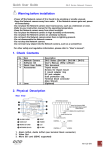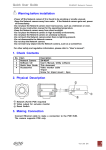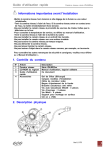Download IPX/IPN Series
Transcript
PixelPro GXi Series Web Page User’s Manual Table of Contents WHAT’S NEW................................................................................................................ 5 1. INTRODUCTION ........................................................................................................ 7 1.1. Welcome .......................................................................................................................7 1.2. Getting Started ..............................................................................................................7 1.3. IP Address Setting ..........................................................................................................7 2. USING A WEB BROWSER .......................................................................................... 9 2.1. ActiveX Installation (AxUMF.cab) ..................................................................................9 2.2. Recommended PC Specification .................................................................................. 11 3. LIVE PAGE CONFIGURATION ................................................................................... 12 3.1. Log In ........................................................................................................................... 12 3.2. Live Page Menus .......................................................................................................... 13 4. STORAGE CONFIGURATION .................................................................................... 16 4.1. Storage device settings ................................................................................................ 16 4.1.1. USB/SD Storage ..................................................................................................... 16 4.1.2. FTP ........................................................................................................................ 17 4.2. Recording..................................................................................................................... 18 4.2.1. Recording file format ............................................................................................. 18 4.2.2. Continuous recording ............................................................................................ 18 4.2.3. Event recording ..................................................................................................... 20 4.3. Search and file-download ............................................................................................ 21 4.3.1. Continuous recording file download ...................................................................... 21 4.3.2. Event Search & download ...................................................................................... 21 5. SETUP ..................................................................................................................... 22 5.1. Basic Configuration ...................................................................................................... 22 5.1.1. Users ..................................................................................................................... 22 5.1.2. TCP/IP.................................................................................................................... 22 5.1.3. Date and Time ....................................................................................................... 22 5.1.4. Stream ................................................................................................................... 22 5.2. Video and Audio .......................................................................................................... 23 5.2.1. Camera (channel naming/video format/ color control) .......................................... 23 5.2.2. Repositioning......................................................................................................... 27 5.2.3. Zoom/Focus........................................................................................................... 30 11-2013-A 2 PixelPro GXi Series Web Page User’s Manual 5.2.4. Burnt-in Text.......................................................................................................... 31 5.2.5. Encoder profile ...................................................................................................... 32 5.2.6. Stream ................................................................................................................... 37 5.2.7. Privacy Mask.......................................................................................................... 38 5.3. EVENT CONFIGURATION .............................................................................................. 40 5.3.1. Event Rules ............................................................................................................ 40 5.3.2. Motion Detection .................................................................................................. 46 5.3.3. E-mail recipient ..................................................................................................... 48 5.3.4. FTP Notification ..................................................................................................... 50 5.3.5. HTTP Notification................................................................................................... 52 5.3.6. TCP Notification ..................................................................................................... 54 5.3.7. TCP Server ............................................................................................................. 55 5.3.8. Multicast Notification ............................................................................................ 55 5.3.9. Heart beat ............................................................................................................. 55 5.4. Network Configuration ................................................................................................ 56 5.4.1. TCP/IP(DHCP, Static IP, DNS setting........................................................................ 56 5.4.2. Web Server............................................................................................................ 57 5.4.3. NTP Server............................................................................................................. 58 5.4.4. UPnP ..................................................................................................................... 58 5.4.5. RTSP/RTP (multicast or unicast) ............................................................................. 59 5.4.6. mDNS (Multicast DNS) ........................................................................................... 62 5.4.7. SMTP ..................................................................................................................... 63 5.4.8. DDNS (Dynamic DNS) ............................................................................................. 64 5.4.9. SNMP .................................................................................................................... 65 5.4.10. Wireless LAN ....................................................................................................... 65 5.5. VCA .......................................................................................................................... 68 5.6. Peripheral .................................................................................................................... 68 5.6.1. Sensor/Alarm......................................................................................................... 68 5.6.2. PIR ......................................................................................................................... 69 5.6.3. Serial Port .............................................................................................................. 69 5.7. PTZ settings ................................................................................................................. 70 5.7.1. Touring .................................................................................................................. 70 5.7.2. Autorun ................................................................................................................. 71 5.7.3. Protocols ............................................................................................................... 71 5.8. Maintenance ............................................................................................................... 72 5.8.1. Users ..................................................................................................................... 72 11-2013-A 3 PixelPro GXi Series Web Page User’s Manual 5.8.2. Date & Time .......................................................................................................... 73 5.8.3. API ......................................................................................................................... 75 5.8.4. Language ............................................................................................................... 75 5.8.5. Firmware Upgrade ................................................................................................. 75 5.8.6. System Log ............................................................................................................ 77 5.8.7. Event Search .......................................................................................................... 78 5.8.8. Configuration Import/Export ................................................................................. 79 5.8.8. Reset All Settings ................................................................................................... 80 5.8.9. Reboot................................................................................................................... 81 5.9. About........................................................................................................................... 82 5.9.1.Information ............................................................................................................ 82 5.9.2. License .................................................................................................................. 82 APPENDIX(A) : ENCODERS .......................................................................................... 83 Video-In .......................................................................................................................... 83 Encoder Profile................................................................................................................ 84 Information ..................................................................................................................... 85 REVISION HISTORY ..................................................................................................... 86 11-2013-A 4 PixelPro GXi Series Web Page User’s Manual WHAT’S NEW K1.2.0 [Network Configuration] HTTP is added. [Maintenance] System log is added. [Maintenance] Firmware Update is changed. [Basic Configuration] Users is changed. [Video&Audio] Repositioning is changed. [Video&Audio] Stream is changed. [Event Configuration] TCP Notification is added. [Event Configuration] TCP Server is added. [Event Configuration] Multicast Notification is added. [Event Configuration] Event Profile is changed. [Peripheral] DI/DO is changed. K1.4.0 [General] ONVIF support [General] Supports 3rd party (ExacQ VMS, GENETEC) software [General] multilingual support (Chinese) [Maintenance] DB maintains the setting after the F/W update [Maintenance] Configuration imported export capability added [Added] UserFS support [Added] Authentication option added in RTSP (Network Configuration) [Added] Motion Metadata [Added] 640 x 360 resolution support [Added] White balance mode added in Camera setting [Added] SNMP added under Network setup [Added] Language setting [Change] Repositioning UI improvement and Pan/Tilt motor revolution’s indication [Change] Refresh Interval tab (Live – Panel – Status) moved to top [Change] Video stream description (Setup – Video & Audio – Stream) in UI revised [Change] “Firmware Update” in web UI is now “Firmware Upgrade” [Change] 2nd stream enabled when VCA is active [Change] TI H264 Codec used [Change] HTTP API response time improvement [Change] Configured HTTP port now maintains even after S/W factory reset [Change] Burnt-in-Text unavailable if screen resolution is smaller than 352x240 [Change] 2nd stream now also transfers metadata when VCA is activated [Fixed] Firmware upgrade from IPAdmintool error fixed [Fixed] Symbol letter “%” now can be used in Friendly Name box [Fixed] Flashing Log-in window in Opera browser effect is now fixed [Fixed] Buttons appear smaller in setup page after factory reset is now fixed [Fixed] Heartbeat bug that occurs when CBR’s bit-rate is set too high or too low fixed K1.4.0.7 [Change] Recording option [Added] FTP recording as the event action K1.4.0.10 11-2013-A 5 PixelPro GXi Series Web Page User’s Manual [Change] Day & Night setting K1.4.1.10 [Added] PTZ panel in Live View Page [Added] WDR and Auto Focus Mode in Camera Settings [Added] PTZ Toruing and Autorun configuration K1.5.0.9 [Added] Third party API and Onvif options. [Added] Recording in SD memory as the event action. [Added] Event search and Download the recording file. [Change] Exposure control options. [Added] Privacy Zone options K1.5.0.12 [Fixed] Classification Filter not applied in zones and rules in VCA K1.6.0.4 [Added] Features relevant to the encoder [Added] Video-In menu for the encoder [Added] Video resolution for the encoder [Added] RS-485 configuration page [Change] PTZ configuration page [Added] RACK system information on About page [Change] Relocation of Event Search to the maintenance category in Setup [Added] Image Rotation in Camera Setting [Change] Minimum shutter speed changed from 1/5000 per second to 1/10000 per second. [Added] Smart IR function [Added] Refocus for transition of day and night [Change] Privacy Mask setting for PTZ positional change [Added] Trigger mode in VCA source in Event Rules [Added] Inactive option for DI in Event Source under Event Rules [Added] Attaching snapshots of pre image in e-mail notification in Event Action in Event Rules [Added] Duration (time extension) setting for DI in Sensor/Alarm [Added] Replay attack protection for ONVIF in API maintenance setting [Change] UI rearranged in API maintenance setting [Added] Link-local address in TCP/IP [Added] Option of ‘basic’ in Authentication type under RTSP/RTP [Added] Options of NO-IP and FreeDNS in DDNS Protocol Type [Added] Save event log in Event Action under Event Rules [Added] Multiple DIDOs in Event Configuration 11-2013-A 6 PixelPro GXi Series Web Page User’s Manual 1. INTRODUCTION 1.1. Welcome This manual explains how to interface with the H.264 codec supporting IP camera series using the Microsoft® Internet Explorer web browser. The Web Page of the product has been implemented with the protocols below: HTTP API – Parameter configuration commands RTP/RTSP – Video, Audio, and Metadata Streaming Active X program – Image display on client PC 1.2. Getting Started Before utilizing the web interface, install and connect the camera and other physical devices. Refer to the hardware manual supplied for the product installation steps. The installation manual provides detailed information for installation and configuration of the device. 1.3. IP Address Setting How to find the IP Address of your device: The product has its unique IP address, and users can identify the address by converting the MAC address’ last two digits of hexadecimal numbers described on the sticker that is attached to the device. Refer to the following figure, and convert the MAC address to an IP address. Type the identified IP address in the address bar of the Internet Explorer to access the web page of the product. MAC address = 00-1C-B8-01-23-45 → IP address = 192.168.35.69 Convert the last two sets of hexadecimal numbers to decimal numbers. 11-2013-A 7 PixelPro GXi Series Web Page User’s Manual How to change the default IP address: IPAdminTool software allows users to search and change the IP address of connected devices. The figure below shows a main UI of the IPAdminTool. The IPAdminTool helps to search multiple devices. Please refer to the ‘IPAdminTool User’s Manual.pdf’ for the detailed information and its usage. What is IPAdminTool? IPAdminTool automatically scans all of the products including encoders and cameras on the network and displays product’s information, including product name, IP address, MAC address, firmware information, and devices’ uptime. The tool also allows users to change the IP address or update the firmware. It is highly recommended for users to review before using this tool for better understanding the software functions and administration controls. Limitation of the concurrent clients Depending on streaming configurations and settings, simultaneous connections might reach the limitation due to system maxed-out capability. RTSP Streaming, Unicast: Heavily depends on the maximum throughput in a given time. 11-2013-A 8 PixelPro GXi Series Web Page User’s Manual 2. USING A WEB BROWSER After the network and power connection are established, access the web browser to view the live streaming of the connected device. Installation of the ActiveX is required to see the live page and to access full controls in Microsoft® Internet Explorer. 2.1. ActiveX Installation (AxUMF.cab) For full control of a device through a web browser, installation of the ActiveX control is required. Refer to the following steps to install the ActiveX. Disable the Pop-up blocker or run “Add-on” notice in a browser to install the ActiveX and Installation file. 1. Click the installation warning message on the view page as below. JPEG snapshot is displayed every 1 second before you install AxUMF.cab 2. Click the Install button on the security warning message box. If the page is not responding after the installation, refresh the page. 3. Install“setup.exe” by clicking the link shown on the main page. JPEG snapshot is displayed every 1 second before you install “setup.exe”. 11-2013-A 9 PixelPro GXi Series Web Page User’s Manual 4. Follow the instructions of the dialog boxes, and complete the installation. 5. When the dialog box appears to request user name and password, enter the default value for the administrator account (case-sensitive) as below: User Name: root Password: pass 6. Refresh the page and check if the live image is displayed successfully. i Note 11-2013-A If ActiveX is not run properly, please make sure all of your software components are up to date: .NET Framework V3.5 http://www.microsoft.com/en-us/download/details.aspx?id=21 Microsoft Visual C++ 2008 SP1 Redistributable Package (x86) http://www.microsoft.com/en-us/download/details.aspx?id=5582 10 PixelPro GXi Series Web Page User’s Manual 2.2. Recommended PC Specification The following table describes the recommended requirement of the PC system to use a Web browser with our products. Item VGA OS Direct X i Recommended D3D support XP, Vista, 7 9.0 Only Internet Explorer 8 or higher version x86 is officially supported. Note 11-2013-A 11 PixelPro GXi Series Web Page User’s Manual 3. LIVE PAGE CONFIGURATION When the device is accessed via the web browser, the live image of the device appears on the window. To go back to the Live page either from the Storage or Setup page, click Live on the upper left corner of the web page. 3.1. Log In To access the device on the web browser: 1. Enter root for the user name and pass for the password on the pop-up window. 2. Click the OK to access the main page. 11-2013-A 12 PixelPro GXi Series Web Page User’s Manual 3.2. Live Page Menus Option Tab Panel: Clicking the Panel button enables users to hide/show the menu tabs. Stream: The drop-down box displays available streams of the camera for users to select from. Size: Users may select the size of image that is displayed on a web page. - Fit: Image size is reduced / enlarged to “fit” into the current web window. - 25%: Image size is reduced to a quarter of original resolution. - 50%: Image size is reduced to a half of original resolution. - 75%: Image size is reduced to three quarters of original resolution. - 100%: Image size is displayed as its original resolution size. - 150%: Image size is 50% more enlarged than its original resolution size. - Full: The image is shown on a full screen mode. Trigger-Alarm(DO): Users may enable or disable the alarm. Setting up the alarm from the setting menu is required. (Setup > Peripheral > DI/DO) Audio: - Audio-Speaker will be activated when the Enable check box of Audio Input (Setup > Stream > Audio) and Enable audio stream check box (Setup > Network Configuration > RTSP/RTP) are ticked. - Audio-Microphone will be activated when the Enable check box of Audio Output (Setup > Stream > Audio) is ticked. 11-2013-A 13 PixelPro GXi Series Web Page User’s Manual Status Tab Status: Status panel displays items listed below. - Refresh Interval: Refreshing interval of the status panel. - CPU: Usage of CPU - Memory: Usage of memory - Time: Time after booting - First Stream/Second Stream/Snapshot: Current information of each stream. If the live image is not shown, 1. Check if the camera is powered on and connected properly. 2. When using the Internet Explorer, check if the ActiveX control is installed. For other types of web browsers, the live image is displayed via QuickTime Player. 11-2013-A 14 PixelPro GXi Series Web Page User’s Manual PTZ Tab PTZ Tab is shown if the model supports PTZ operation or it is Speed PTZ camera. Direction Movement: Click the desired button to move Pan/Tilt. Zoom In/Out: Click ‘+’ button to zoom in (Tele) and ‘-‘ button to zoom out (Wide). Focus Near/Far: Click ‘+’ button to focus in near and ‘-‘ button to focus in far. Speed: Adjust the speed of the pan/tilt control. Pre Position: Preposition can be set up to 255. Tour: Tour shows the video stream from the different preposition in a pre-defined order for intervals. Select the Touring Number and then click the Start button to start the predefined Touring. If you want to stop Touring immediately, Click Stop button. Please refer to 5.7.1 Touring for the configuration. Home Position: One position can be set as the Home position which is readily accessible by just clicking “Go” or goes to when there is no operation with Autorun. Please refer to 5.7.2. Autorun for the configuration. 11-2013-A 15 PixelPro GXi Series Web Page User’s Manual 4. STORAGE CONFIGURATION From the Storage page, a user can configure a storage device and recording. 4.1. Storage device settings 4.1.1. USB/SD Storage To search for mounted USB or storage devices and check the device information, click Storage . ① Device List: The mounted devices are listed by clicking “Refresh USB/SD Device List”. ② Device Information: The detailed information of the selected storage device is displayed. The information includes device name, type, total capacity, free space, and device status. ③ Record Device Control: allows users to format a storage device as vfat or ext3 file system, and mount or eject storage device that is available from the device list. i Note Ext3 file system is recommended due to its resilience against data loss in case the card is ejected or if there is abrupt power loss. Class 4 or higher Class SD card is recommended when recording high resolution video. To start the recording, the device must be connected. If the connected device does not appear, try to reboot the device and check its status again. 11-2013-A 16 PixelPro GXi Series Web Page User’s Manual 4.1.2. FTP To specify the FTP server to record the video and audio, click Storage > FTP. Please note that this is the configuration for FTP server used only for the event recording. Please refer to 4.2.3 Event recording and 5.3 Event Configuration for more details. Name Specify the FTP server name. IP Address Enter the FTP server address. Port Enter the server port number. The default is 21. Target Directory Enter the target directory to store the data. Account Enter the login user name of the FTP server. Password Enter the password of the FTP server. Prefix of filename Relevant name that will be used as the recorded file. For easier recognition of duplicate files, the end of every recording file name includes the serial number which device uploads the recording file, date/time, and index information as a default. i The date and time in the recorded file name is based on UTC time. Note 11-2013-A 17 PixelPro GXi Series Web Page User’s Manual 4.2. Recording 4.2.1. Recording file format Continuous In this mode, the media data is striated as Standard AVI format that is a multimedia container format. Event The camera owns recording file format that can be used for the event recording. 4.2.2. Continuous recording For the Continuous configuration, click Storage > Recording > Configuration. On this page, users can configure the recording storage option and recording conditions and perform the instant recording. 11-2013-A 18 PixelPro GXi Series Web Page User’s Manual Recording storage Options - Storage device: SD card is pre-ticked and selected. - Recycling options Users can select one of the options when the storage is full. Stop recording: Stops recording and keeps the recorded data. Delete files and recycle (oldest first): Replaces oldest files with latest files (based on dates). Recording Setting - Prefix of filename Give relevant name that will be used as the recorded file. For easier recognition of duplicate files, the end of every recording file name includes the date and time information as a default. - Recording resource Select the choice between ‘Video only’ and ‘Audio+Video’. - Rule of segmentation (by) Size: The range of the file size is from 100 to 1440 Megabytes. (by) Time: The range of the recording length is from 5 to 20 minutes. - Stream source Users may choose primary recording source from either first stream or second stream. If it is a single stream, the second stream option is unavailable. Instant Recording If the Start button is pressed, the recording will be started immediately. Before pressing the start button, input recording time (seconds) in the box next to the start button. The system default is 60 seconds, and the available recording time is from 10 to 600 seconds. (10 minutes) While the recording is in progress, the button label changes from “Start” to “Stop”; Users can manually stop the recording while it is being progressed. NOTE: If Instant Recording doesn’t show on the page, make sure to select Continuous, and click Apply. When the recording is complete, click ‘download’ button appears on far right; Click the button to download the recording as a file. 11-2013-A 19 PixelPro GXi Series Web Page User’s Manual 4.2.3. Event recording To configure the event recording, click Storage > Recording > Configuration, and then select Event of Recording Format. On this page, users can choose the desired storage (SD card, or FTP server) for event recording and set related recording parameters. Recording storage Options Select the storage device type. If FTP is selected, the SD memory can be used as a buffer to transfer stably. Recording Setting - Recording resource Select the choice between ‘Video only’ and ‘Audio+Video’. - Event hold off time Specify the time between the successive triggered events so as to ignore the often repeated event. Stream source Users may choose primary recording source from either first stream or second stream. If it is a single stream, the second stream option is unavailable. 11-2013-A 20 PixelPro GXi Series Web Page User’s Manual 4.3. Search and file-download 4.3.1. Continuous recording file download To view and download the recorded files, click Storage > Search & Download > Continuous Download. All of the recorded files are listed with maximum 40 files per page on the File Download page. Currently recording file is displayed as [Recording] on the Download column. Users can select the desired file from the list or search it by date. To list up the files which are recorded on a specific date only, click on the Search box. A calendar appears from the search box and select the desirable date. To go back to the original list, click the ‘x’ button next to the Search box. To download a file, click [Download]. Then, the pop up window appears for the file download. 4.3.2. Event Search & download To search event and download the corresponded recorded files, click Sotrate > Event Search & Download. 1. 2 - 1. Users can select or specify a period. - 2. Users can select event types. - Event Rule Name: The name defined when creating the rule - Type: The event type selected on the 3rd row - Rule Time: The time that the event was detected - Description: Additional information about the event - Download: Clicking a floppy disk icon enables users to download the file. 11-2013-A 21 PixelPro GXi Series Web Page User’s Manual 5. SETUP To configure the setting values of the device, click Setup on the main page. To access the Setup page, ID and passwords are required. 5.1. Basic Configuration The Basic Configuration provides the menus required for the basic settings that users must configure after the camera installation. 5.1.1. Users Refer to 5.8.1. Users to get information on how to add, modify, or remove the web page users. 5.1.2. TCP/IP Refer to 5.4.1. Setting TCP/IP (DHCP, Static IP, DNS setting) for TCP/IP configuration. 5.1.3. Date and Time Refer to 5.8.2. Date & Time for time and date setting. 5.1.4. Stream The Stream configuration page from Setup > Basic Configuration > Stream operates the same way as of the page from Setup > Video & Audio > Stream. Refer to 5.2.6. Stream for the details. 11-2013-A 22 PixelPro GXi Series Web Page User’s Manual 5.2. Video and Audio To change the setting for video input, burnt-in text, encoder profile, and steam, go to the Video & Audio page by selecting Setup > Video & Audio. This menu is configured with five sub menus: Camera, Repositioning, Burnt-in Text, Encoder Profile, and Stream. 5.2.1. Camera (channel naming/video format/ color control) The camera setting page provides options to: Name a channel for the camera Set image attributes Adjust the image exposure Configure Day & Night mode Configure the image signal processing Preview the current setting 1. Click Preview to see how the image will appear on the preview window at the bottom of the page prior to the actual modification of camera setting. 2. Click Apply to save changes, and click Cancel to return to the previous setting. 11-2013-A 23 PixelPro GXi Series 11-2013-A Web Page User’s Manual 24 PixelPro GXi Series Web Page User’s Manual Friendly name Users may provide friendly name (alias) to an individual camera in case when utilizing multiple channels and cameras. Using alias is recommended to distinguish the device where environment requires multiple image feedbacks with multiple monitoring devices. Video Appearance Brightness, contrast, saturation, sharpness and orientation are adjusted. Brightness: The range is from 0 to 255, the default is 128. Contrast: The range is from 0 to 255, the default is 128. Saturation: The range is from 0 to 255, the default is 128. Sharpness: The range is from 0 to 255, the default is 128. Orientation: Select vertical flip or horizontal mirror an object. Vertical Flip This enables an image to be rotated vertically. Horizontal mirror This enables an image to be mirrored. i Note Sharpness is affected by installation environment. Here in the web menu’s “range” definition is operating range, therefore configuring the right value for each camera is necessary. Rotation Rotation function is a corridor mode which rotates the video image 90 degrees in an area that is more vertical than horizontal in shape such as staircase, hallways, aisles to view a vertically oriented video stream. The options are ‘Normal’, ‘Left(-90°)’, and ‘Right(+90°)’. i Image rotation using high resolution (1080p) may affect the frame rate. Note Exposure control Selecting the right exposure control mode depends on the installation site’s environment. 3 modes are available; Auto : This mode tries to adjust the best shutter speed automatically to get the proper scene depending on the light environment from the minimum shutter speed. Manual : If the auto mode doesn’t work properly or you want to fix the shutter speed, you may select this mode and set the shutter speed manually. Flickerless : Under the florescent light, the flicker may happen and select proper light frequency to compensate the light flickering. Exposure adjustment Correct exposure value should be selected from the list box to adjust the target brightness for the automatic exposure setting. The high value makes the image brighter, and the low value makes the image darker. Select the value as follows: +1.0, +0.6, +0.3, 0, –0.3, –0.6, –1.0(EV) 11-2013-A 25 PixelPro GXi Series Web Page User’s Manual Backlight compensation (BLC) allows the camera to adjust the exposure of the entire image to properly expose the subject in the foreground based on the selected light measuremend area when a bright light source in behind the subject of interest. Digital slow shutter allows to get the proper exposure in low light condition even the frame rate may be dropped. Smart IR enables to automatically adjust the IR power output depending on the surrounding light conditions. It also eliminates overexposure if a subject is detected closer to the camera. Auto: This mode adjusts the pre-defined levels of the IR power output. The pre-defined range is from 0 to 255. Manual: A user determines an appropriate level of the IR power output and adjusts it manually. i Note Smart IR feature is available only for the specific camera models equipped with IR LEDS. Digital Wide Dynamic Range (DWDR) This ensures image clarity in strongly lit and contrasting places. Auto Focus Mode (Note: Auto focus mode is for speed PTZ cameras only.) Autofocus allows the lens to remain in focus during tele, wide and direction movement operating automatically. There are three modes. - Auto: this mode enables to focus automatically. - Semi-auto: This mode allows adjusting focus once automatically in the below cases. PAN/TILT movement Zoom In/Out Change Preset position The PTZ position change by Autorun - Manual: This mode allows user to change the focus with Focus Near/Far control. Day & Night Three different day/night modes are supported: Auto, Day, and Night. Select the desired mode based on the installation environment. Default value is Auto. Threshold value for Day to Night and Night to Day can be controlled when the Auto mode is set. Please note that Night to Day level should always be set higher than Day to Night level. - Day to Night level: This has range of 0 ~ 63. (Default value is 0) - Night to Day level: This has range of 1 ~ 64. (Default value is 3) White Balance Set of different white balance modes are available in drop down list, and Red and Blue hues can be adjusted. - atw1: Automatically adjust white balance in image - atw2: Automatically adjust white balance but with different range compare to atw1 - push: Applies adjusted white balance to image. - manual: users can manually adjust red and blue hues 11-2013-A 26 PixelPro GXi Series Web Page User’s Manual Image Signal Processing When noise filter value is 0, the noise filter is off. The noise suppression is performed to the maximum when the value set is 15. The video quality will suffer when the value is set to the highest. The range is from 0 to 15, and the default is 0. Analog output (Note: Analog Output selection is available for speed PTZ cameras only.) This selects the video format on the video output port. Using the Preview button Preview window appears with current setup visuals. When settings are applied, the preview window displays the user’s latest modification. 11-2013-A 27 PixelPro GXi Series Web Page User’s Manual 5.2.2. Repositioning Note: This part is for the repositionable dome cameras only. To change the repositioning setting, go to Setup > Video & Audio > Repositioning 11-2013-A 28 PixelPro GXi Series Web Page User’s Manual Movement - Arrow buttons: The camera can move to 4 directions; up, down, left, and right. The camera moves to the desired position while the button is clicked and held. Stop button can be used while using zoon/focus settings or auto focus settings. - Zoom/Focus buttons: 3 levels of movements are available for wide, tele, near and far movements. Clicking the buttons move the lens more extensively than the buttons . - One Click Focus: Clicking this button automatically sets the lens focus. Pre Position - Drop-down list: Stored position list (available to store maximum 16). - Name: Text box to enter name of appointed position. - Go: Clicking Go moves the camera to the selected position after selecting one from the drop-down list - Set: Saving the current camera position. - Clear: Removing the current camera position. Calibration - Pan/Tilt: Move Pan and Tilt to default location. - Zoom/Focus: Move zoom and focus to default location Status - Cycle(Pan)/ Cycle(Tilt): Pan and Tilt cycle status. Numbers indicate pan and tilt motor’s number of revolutions. Schedule - Set up to 4 schedules of prepositions to focus on during desired date and time periods. 11-2013-A 29 PixelPro GXi Series Web Page User’s Manual 5.2.3. Zoom/Focus Note: Zoom/Focus is for motorized lens cameras only. To change the Zoom/Focus setting, go to Setup > Video & Audio > Zoom/Focus - Zoom/Focus: Three levels of movements are available as wide, tele, near and far. Clicking the buttons move the lens more extensively than the buttons . - One Click Focus: Clicking this button automatically sets the lens focus. - Calibrate (Zoom/Focus): This function rectifies misalignment by rebooting to a zero point and then aligning to a correct position. 11-2013-A 30 PixelPro GXi Series Web Page User’s Manual 5.2.4. Burnt-in Text To change the burnt-in text setting, go to Setup > Video & Audio > Burnt-in Text. The setting of the Burnt-in Text is applied to first stream, second stream (if the device supports) and snapshot modes identically. To add burnt-in text, check on the box of Enable B-I Text after the setting and click Apply What is Burnt-in Text? Burnt-in Texts ‘burns’ information into streaming visuals before it gets compressed, thus prohibiting manipulation or alteration of the events’ time. It allows the file to become reliable evidence as it discourages intentional manipulation of the date and time for an alibi. Text configuration Select information (Date, time and name) to include as the burnt-in text in image. To include a specific name or info, type the desired text on the name text box. To display millisecond (time), check the ‘Enable milliseconds for time display’ checkbox. Text position Set where the burnt-in text will be positioned in image. Predefined locations are provided as well as manual position options. i Note It is recommended to use normalized X, Y instead of predefined positions (left-top, left-bottom, right-top, right-bottom) for the burnt-in text positions. Selecting same predefined positions on all three categories may cause overlapping texts, depending on image resolution or the position of each text. Utilizing PREVIEW is highly encouraged to review the selected positions of those burnt-in texts. Preview Preview button allows to view the visual with applied settings (need to press APPLY to view). 11-2013-A 31 PixelPro GXi Series Web Page User’s Manual 5.2.5. Encoder profile To create pre-defined encoder profiles, go to Setup > Video & Audio > Encoder Profile. You can check all the profiles on the Encoder Profile page, and add, copy, modify, or remove a profile. Stream Profile List: It shows a list of defined encoder profiles. Clicking a highlighted profile shows the detailed information about the profile. Click Add to create a new profile, and click Copy to easily create a duplicated profile. If you want to modify a currently existing profile, click Modify, and make changes on the existing setting. Clicking Remove gets rid of the highlighted profile on the list, but the default profile cannot be removed. 11-2013-A 32 PixelPro GXi Series Web Page User’s Manual If you click either one of Add, Copy, or Modify button, the profile configuration page appears as shown below. On this page, users can configure the settings for each stream, snapshot and audio separately. Users can configure streams, snapshot and audio settings. Click APPLY to apply all changes to the current profile, or click Cancel to go back to the last saved profile. Stream Configuration (First Stream and Second Stream) The expected codec usage The expected codec usage is calculated automatically according to your configuration parameters. Do not exceed the usage over 100%. * The expected codec usage does not appear for encoders. Enable streaming Check the ‘Enable streaming’ box to enable streaming on the selected stream. Always keep unused streams disabled. Video codec Select the video codec from MJPEG and H.264. 11-2013-A 33 PixelPro GXi Series Web Page User’s Manual Resolution The supported resolution in pixels for the current stream profile is listed on the drop down box. Select the desired resolution. For encoders, refer to APPENDIX[A]:ENCODERS. Cameras 1920x1080 1280x720 1120x630 960x540 800x450 640x360 480x270 320x180 Maximum FPS Define the desired frame rate per second. The max frame rate is 30 for cameras. For encoders, refer to APPENDIX[A]:ENCODERS. GOP This parameter defines the length of the group of pictures. If this value is set to 1, the video stream will only have one I-frame. Keep this value high to minimize bandwidth. The max GOP is 30. For encoders, refer to APPENDIX[A]:ENCODERS. Profile Identification This option allows users to select between three H.264 different profiles. This directly affects the quality of the video due to the amount of compression applied. Baseline profile provides maximum compression to the video. High profile gives the best quality. Selecting the Main profile is balances between the other two. Variable Bit Rate (VBR) VBR allows a higher bitrate (and therefore more storage space) to be allocated to the more complex segments of media files while less space is allocated to less complex segments. It is used when the system has enough storage and a high quality image is required. Image quality can be configured as highest, high, normal, low and lowest. Constant Bit Rate (CBR) CBR mode maintains the defined bitrate level all the time. Snapshot Configuration Once ‘Enable snapshot’ is ticked, it will not stop until the checkbox is unchecked and ‘Apply’ is pressed. Enable snapshot Tick Enable snapshot to enable snapshot on the selected stream. 11-2013-A 34 PixelPro GXi Series Web Page User’s Manual Resolution The supported resolution for the product is listed on the drop down box. Select the desired resolution. If one of the video streams is set to 1080P, other video stream resolution cannot be used as greater than 1088 horizontal. Maximum FPS Enter how many snapshot files you want to send per a second. The maximum value is 5. JPEG quality Enter the JPEG quality. The range is from 0 to 100 and ‘100’ means the best quality. 11-2013-A 35 PixelPro GXi Series Web Page User’s Manual Audio Configuration Enable audio Select the Enable check box for the microphone or speaker to be enabled. Audio Input Volume: Enter the audio input volume. The available range is from 0 to 225. Codec: G.711 is supported for the audio codec. Sampling Frequency: The sampling frequency is selectable between 8kHz and 16kHz. Audio Output Volume: Enter the audio output volume. The available range is from 0 to 255. TCP/IP listen port: Set the port for listening to the audio received from the camera. The default is 6000 and the range is from 1 to 65535. i After the setting, make sure to click OK to save changes. Note 11-2013-A 36 PixelPro GXi Series Web Page User’s Manual 5.2.6. Stream To configure predefined stream profile, go to Setup > Video&Audio > Stream. This part has the same structure as in Setup > Encoder Profile, and actual stream is applied on this page. Clicking Show profile list will display all the profiles that you had previously added in 5.2.5 Encoder profile .* 1. Highlight a profile that you wish to configure from the list, and click Load profile settings to bring up its setting below the Stream panel. 2. Click Apply to implement all changes to the currently loaded profile. Or, click Cancel to reverse all the changes made on this page to the latest-applied values. *Different values for streaming can be applied by directly changing the values below the Stream panel other than setting profiles thru Encoder Profile. 11-2013-A 37 PixelPro GXi Series Web Page User’s Manual 5.2.7. Privacy Mask To set up the privacy mask, go to Setup > Video & Audio > Privacy Mask. How to configure privacy mask zones except repositioning camera 1. Check “Show” button of the desired privacy zone ID on the information panel. 2. On the display window, click the left mouse button and drag the mouse diagonally until the desired size is made. 3. Click the “Save” button to save changes. 11-2013-A 38 PixelPro GXi Series Web Page User’s Manual repositioning camera 1. Move to the area where privacy mask is needed by clicking the arrow buttons under the Movement tab. 2. Tick the checkbox of a desired Zone ID, type an easily recognizable name under the name tab, and set the mask position and size by entering appropriate values under the Position tab based on Center and Range information. 3. Click SAVE to apply the privacy mask on the screen. 4. Adjust and resize the privacy mask to completely cover the object you targeted by changing the values you had entered. If you want to see each privacy mask you already set in different areas on the screen, click GO. What are P,T,W, and H? P means Pan, indicating the camera’s panning position. The value is from 0 to 360. T means Tilt, indicating the camera’s tilting position. The value is from -25 to 70. W means Width, indicating the width of privacy mask. The value can be from 1 to 40. H means Height, indicating the height of privacy mask. The value can be from 1 to 30. *The sum of the T value and the H value should be less than or equal to 70. What is Center ? It is the coordinate of Pan and Tilt, whose location is center of the video on the screen. What is Range? The range indicates vertical and horizontal view angle of the video on the screen. 11-2013-A 39 PixelPro GXi Series Web Page User’s Manual (Center50,45) W(15) P(57.5),T(45) H: 35 Object H(8.75) W: 60 < Example of Privacy Mask shown on the screen > How to draw the privacy mask above Let’s suppose there is an object you want to hide inside the privacy mask zone. The center of the camera is located at the coordinate, (50, 45) of pan and tilt, and the horizontal and vertical view angles are 60 and 35 respectively. 1. Let’s define the initial point to cover the object. The object is away toward the right by 1/4 horizontally and on the same line vertically from the center. Thus, the values of the initial point are 57.5 and 45, which are respectively P value and T value. 2. To fully cover the object horizontally, there needs to be two squares from the red point(P,T) to the right, whose width is 2/4(=15). Therefore the W value is 15. 3. To fully cover the object vertically, there needs to be one square downward from the red point(P,T), whose height is 1/2(=8.75). Therefore the H value is 8.75. i Note The speed dome cameras have the range limit in tilting. Thus, the field available for privacy mask is also limited. 5.3. EVENT CONFIGURATION Event Configurations allow users to set up the notification of occurred events. The event sources such as DI and motion detection can publish event messages when an event is generated. The available event subscribers include DO, email, FTP, and HTTP. i Note Before you create an event profile, go to the desired subscriber configuration page (E-Mail Recipient, FTP Notification, or HTTP Notification), and complete the required server settings. 5.3.1. Event Rules After the event subscriber configuration, you can make several event profiles with different options of event source and notification. Go to Setup > Event Configuration > Event Rules to manage the event profile. On this page, you can configure the event source type and specify how to send notification message when an event trigger is activated. 11-2013-A 40 PixelPro GXi Series Web Page User’s Manual You can check the defined profile list on the main page, and add, copy, modify or remove an event rule. ① Tick the checkbox of Enable event rules under Configuration tab, and click apply to begin creating event rules. ② Click Add to create an event rule, and select desired Event Sources when a pop up window of Add to Event Rule List appears. ③ Click Event Action tab to select desired Event Actions. ④ Name the event rule on the Configuration section, and tick Enable Rule if you want to use the event rule, and then click OK. ⑤ Clicking on an event rule in Event Rule List will display the detailed information about the highlighted event rule. If you want to copy a profile of an existing event rule, highlight the desired event rule, and click Copy. Copying an event profile allows you to easily create multiple profiles with the same configuration. Clicking Modify enables you to modify the profile of the highlighted event rule. Clicking Remove will get rid of the highlighted event rule from Event Rule List. * Please see the following pages for the detail about the event sources and event actions. 11-2013-A 41 PixelPro GXi Series Web Page User’s Manual Event Source Configuration i Note The supported event source may be different depending on the hardware/software specification of each model. The event sources can be categorized into three different groups for their mutually exclusive operations. When any source from each group is enabled, all the other sources of the other group are disabled. To configure the event sources, click the Event Source tab. Sensor (DI) Select the Enable sensor check box to enable DI as the event source. There is a hyperlink to access the DI/DO configuration page. 1st group Sensor (DI) Select Sensor(DI1) to enable DI as the event source. There are three modes: - Active: Selecting Active enables detection of digital input. - Inactive: Selecting Inactive enables detection of the ending moment of digital input. - Both: combination of Active and Inactive There is a hyperlink to access the Sensor/Alarm configuration page. 11-2013-A 42 PixelPro GXi Series Web Page User’s Manual PIR Select PIR to enable PIR sensor as the event source. There is a hyperlink to access the PIR configuration page. Motion detection Select motion detection to enable motion detection as the event source. Selecting the check box displays the motion interval setting as shown on the screenshot above. Set the time for motion interval from 0 to 3600 seconds to avoid continuous triggered MD events. Then, select the motion detection zones to use as the event source from the list. (Refer to 5.3.2. Motion Detection to create the motion detection zones prior to setting motion detection as the event source.) There is also a hyperlink to access the motion detection configuration page. VCA source Select VCA source if you want a certain VCA source as one of the event sources. Available options may differ by purchased analysis options. There is also a hyperlink to access the VCA configuration page Here is the explanation on some major VCA sources. - Configuration: When VCA configuration is changed - Tamper: When there is camera tampering. - Trigger mode: This mode enables users to set the moments that VCA defines a rule as a trigger. Rising edge: The moment a defined rule begins Falling edge: The moment a defined rule ends Both: combination of Rising edge and Falling edge 2nd group Video loss/detect Select the checkbox of Video loss/detect to enable video status detection as the event source. Network setting changed This option allows users to receive events when network setting is changed. 3rd group Fan/Heater operation changed This option allows users to receive events when the operation of fan and heater is changed. 11-2013-A 43 PixelPro GXi Series Web Page User’s Manual Event Action Configuration i Note The supported event action may be different depending on the hardware/software specification of each model. Active Alarm (DO) Select the check box to activate the DO for the event publisher. The number of active alarm (DO) checkboxes varies depending on each device. Specify the alarm duration. Duration indicates how long the DO works. For example, if you input ‘0,’ a DO device keeps working until you turn it off manually. If you input ’10,’ a DO device will work for 10 seconds and finish the operation. Recording Select the check box to record the video and audio data to the preconfigured FTP or SD memory when the event is triggered. To use this event action, the recording format should be at Storage > Recording > Configuration. The recording format should be Event to enable recording. Pre interval and Post interval specifies the recording duration before and after the event occurs. Save event log It is automatically ticked as an event action in case Network setting changed or Fan/Heater operation changed is selected as an event source. 11-2013-A 44 PixelPro GXi Series Web Page User’s Manual Send E-mail notification Select the check box to send E-mail to designated recipients. To attach a snapshot image, select Attach a snapshot. Up to three snapshots taken before the triggered moment (defined as pre-image on the webpage) can be emailed while one snapshot at the triggered moment can be attached. From the recipient list, select the recipient to send the notification. To create a new recipient that is not on the list, go to Setup > Event Configuration > E-Mail Recipient and create a new recipient information. Once the desired recipient is selected, write the subject for the email. Upload notification to FTP Select the check box to activate the FTP notification method. To attach a snapshot image, select the Attach a snapshot check box. From the FTP server list, select the FTP server to send the notification. To create a new FTP server that is not on the list, go to Setup > Event Configuration > FTP Notification and create a new FTP server information. Send HTTP Notification Select the check box to activate HTTP notification method. From the HTTP notification list, select the HTTP server to send the notification. To create a new HTTP server that is not on the list, go to Setup > Event Configuration > HTTP Notification and create a new HTTP server information. Send TCP Notification Select the check box to activate TCP notification method. To configure a new TCP server, go to Setup > Event Configuration > TCP Notification and configure TCP server information. Send Notification via TCP event server Select the check box to activate TCP event server notification method. To configure a new TCP server, go to Setup > Event Configuration > TCP Server and configure TCP server. Send multicast notification Select the check box to activate multicast notification, and go to Setup > Event Configuration > Multicast Notification to configure multicast notification. Or, go to 5.3.8. Multicast notification for the detail. Active PTZ Select the check box, and select the preset position to move to the specific preset position of PTZ camera. To configure a preset, go to Live > Panel > PTZ > Pre Position. i Note 11-2013-A To attach a snapshot image on the configuration of E-mail Recipient or FTP notification, make sure the snapshot setting from Setup > Video & Audio > Encoder Profile has been enabled. 45 PixelPro GXi Series Web Page User’s Manual 5.3.2. Motion Detection To set up the zones and rules configuration required for the motion detection, go to Setup > Event Configuration > Motion Detection. How to configure the motion detection zones 1. On the Information panel, select Enable on a desired Zone ID. Then, a rectangle appears on the screen. 2. Relocate the rectangle or adjust the size with the left mouse button by dragging the mouse on top or on the edge of the rectangle. The rectangle is motion detection zone. 3. 4. 5. 6. Provide a relevant name and description of the motion detection zone on its text box. Adjust the value sensitivity and object size. Uncheck Enable if you want to hide a motion detection zone. Click Save to apply changes to the screen. * Click checkbox of Enable MD metadata, and click SAVE to apply if you want to see which spot has a subject’s movement on the screen. 11-2013-A 46 PixelPro GXi Series Web Page User’s Manual What is Sensitivity? Every motion detection zone is divided into multiple squares, which is called ‘Macro blocks.’ Each of macro blocks consists in groups of 16 x 16 pixels. The value of sensitivity means the sensitivity of each macro block. To configure the zone less sensitive than the factory default (128), set the number value higher; to configure the zone more sensitive than the factory default, set the number value lower. What is Object size? The object size value means the proportion of the macro blocks which has exceeded the configured sensitivity. If you want to configure the zone less sensitive than the factory default (128), set the number value higher; to configure the zone more sensitive than the factory default, set the number value lower. 11-2013-A 47 PixelPro GXi Series Web Page User’s Manual 5.3.3. E-mail recipient To configure the email recipient list for event notification, go to Setup > Event Configuration > E-Mail Recipient. 1. Clicking Add will bring up a pop-up window, Add to E-Mail Recipient List as shown below. 2. Create an E-mail recipient profile. Name Specify the e-mail recipient name. Description Input a brief description of the e-mail recipient to easily distinguish. E-Mail Address Enter the e-mail address of the e-mail recipient. If you use host name, a valid DNS server must be specified in TCP/IP network settings. Send Test E-Mail To test the entered e-mail address, click the Send Test E-Mail button. If the e-mail address is available, ‘Send okay’ message appears next to the test button. 3. If you want to modify an E-mail recipient’s information, click Modify, and update the information.( Clicking an E-mail recipient under E-Mail Recipient List will display the detail 11-2013-A 48 PixelPro GXi Series Web Page User’s Manual about the selected recipient profile.) If you want to remove an E-mail recipient from EMail Recipient List, click Remove, and click OK to apply the removal when a pop-up window appears to ask you to confirm the removal. *Go to SMTP Configuration: If you want to send test E-mail to the E-mail recipients, you need to configure the SMTP server information first. Go to Setup > Network Configuration > SMTP(E-Mail), and complete the required settings. Refer to 5.4.7. SMTP for more information. i After the setting, make sure to click OK to save changes. Note 11-2013-A 49 PixelPro GXi Series Web Page User’s Manual 5.3.4. FTP Notification To configure the FTP server for event notification, go to Setup > Event Configuration > FTP Notification. You can check the defined FTP server list on the main page, and add, modify, or remove server information. - FTP Notification List: It shows all the defined FTP server names. - Add: Click this button to add FTP server information. - Modify: Select an FTP server name, and click this button to modify the current information of the FTP server. - Remove: Select an FTP server name, and click this button to remove from the list. - Information: It displays the detailed information of the selected FTP server from the list. 11-2013-A 50 PixelPro GXi Series Web Page User’s Manual Clicking either Add or Modify button will display the configuration page shown below. Name Specify the FTP server name. Description Input a brief description of the server to easily distinguish. Address Enter the IP address of the FTP server. Port Enter the server port number. The default is 21. Target directory Enter the folder name where the created files will be placed. If the folder does not exist on the server, the specified folder name will be automatically created on the FTP server. Account and password Enter the login user name and password of the FTP server. The account and password information must be entered even for the anonymous FTP. File name format Select the desired date format. i After the setting, make sure to click the OK button to save changes. Note 11-2013-A 51 PixelPro GXi Series Web Page User’s Manual 5.3.5. HTTP Notification To configure the HTTP server for event notification, go to Setup > Event Configuration > HTTP Notification. You can check the defined HTTP server list on the main page, and add, modify, or remove server information. - HTTP Notification List: It lists the defined HTTP server names. - Add: Click this button to add HTTP server information. - Modify: Select an HTTP server name, and click this button to modify the current information of the FTP server. - Remove: Select an HTTP server name, and click this button to from the list. - Information: It displays the detailed information of the selected HTTP server from the list. 11-2013-A 52 PixelPro GXi Series Web Page User’s Manual Clicking either Add or Modify button will display the configuration page shown below. Name Specify the HTTP server name. Description Input a brief description of the server to easily distinguish. Address Enter the IP address of the HTTP server. Port Enter the server port number. The default is 80. Account and password Enter the login user name and password of the HTTP server. If you want to skip the login authentication process, leave the text boxes blank. Message Enter the message that you want to send with. Enabling the ‘Append detailed information’ will add event details in message. Please note that this requires ‘/’ at the beginning of the message. For example, YES(“/ABABAB”), NO(“ABABAB”) i After the setting, make sure to click the OK button to save changes. Note 11-2013-A 53 PixelPro GXi Series Web Page User’s Manual 5.3.6. TCP Notification To configure the TCP push for event notification, go to Setup > Event Configuration > TCP Push Notification. IP Address, port Type the configuration of TCP server. Connect Timeout TCP push tries to connect to TCP server during the setting time, but if connection is not made during the setting time, TCP push will stop to try to connect. Send Timeout Holding time for data transmission when event occurs. Alive Type You can configure the condition of connection and the default value is Timeout. - Once: Only one connection is made for each event. There is no check that the connection is succeeded or not. Unlimited: The connection continues for data transmission whether event occurs or not. Timeout: After the last data transmission if there is no event for setting time of alive time the connection will be disconnected. Alive Time When alive type is configured as Timeout, the connection will be continued for alive time. 11-2013-A 54 PixelPro GXi Series Web Page User’s Manual 5.3.7. TCP Server To configure the TCP server, go to Setup > Event Configuration > TCP Server. You can use TCP server to get the event notification from the device and send them to the client application. Port Type the utilized port number to deliver the event message program 5.3.8. Multicast Notification To configure the multicast server, go to Setup > Event Configuration > Multicast Notification. You can use Multicast server to get the event notification from the device and send them to the client application. Type Address, port, and TTL according to your system setting. Factory default is 2555. 5.3.9. Heart beat The camera sends the event repeatedly with the specific interval for the client to check the camera alive. 11-2013-A 55 PixelPro GXi Series Web Page User’s Manual 5.4. Network Configuration 5.4.1. TCP/IP(DHCP, Static IP, DNS setting To change the TCP/IP setting, go to Setup > Basic Configuration > TCP/IP. IP Address Configuration IP Configuration by DHCP If you want to get your IP from DHCP server automatically, check this option and click the Apply button. When the dialog box appears on the screen, click the OK button. Use the static IP address If you want to use your device with a static IP, select ‘Use the following IP address’ and input the following information: - IP address: The IP address of your device. The test button shows if the typed IP address is occupied or not. If the typed address is available, “Okay” appears next to the Test button. If the typed address has been taken already, “Fail” appears next to the button. - Subnet mask: The address of subnet mask of your device. - Gateway address: The gateway address of your device. - Broadcast address: It is automatically fixed by the subnet mask and IP address of your own. For example, if you use B class (255.255.0.0) of mask, the broadcast address will be 192.168.255.255. DNS Configuration Type the IP address of DNS server you use. 11-2013-A 56 PixelPro GXi Series Web Page User’s Manual Link-Local Address This is a built-in function that assigns the device an additional IP address, which can be used to access the unit from other hosts on the same segment of the local network. An IP address is automatically assigned when the camera boots up. The camera can have both a Link-Local IP and a static/DHCP-supplied IP address at the same time. The IP address block is from 169.254.1.0.to 16.254.254.255. To change the IP address, click Renew. 5.4.2. Web Server To change the HTTP server setting, go to Setup > Network Configuration > HTTP. The default value of web server is set to HTTP. To change its setting from HTTP to HTTPS, select HTTPS from the menu. It is recommended if enhanced security is required for accessing the web page. The data transmitted by HTTPS is encrypted by SSL to strengthen the security. What is SSL? SSL is the abbreviation of Secure Socket Layer. SSL protects web server and makes it easy for users to trust the contents. When HTTPS is being utilized to communicate with a server, the SSL certificate is required for the web server and the certificate enables encryption of video and audio data during online transactions. OpenSSL is one of the data security protocols for Linux system, which is used for the product. Setting the port number of web server To communicate with server by HTTP or HTTPS with TCP, the port number should be in between 1 and 65535. The default value is 80. Redirecting HTTP to HTTPS Even when a user tries to access the server with http, it is possible to enable the server to be redirected to HTTPS. In this case, do not set the value ‘80’ as the port number since it may cause a conflict with HTTP port. Authentication Type When accessing the page which requires authority, the web browser asks ID and password and then transfers them to the camera by the methods below. Basic: It uses simple way of encryption of ID and Password with clear text Digest: It uses more enhanced way of encryption. 11-2013-A 57 PixelPro GXi Series Web Page User’s Manual 5.4.3. NTP Server To change the NTP server setting, go to Setup > Network Configuration > NTP. NTP Server Lists Users can set up to four NTP servers. To enable the NTP servers, DNS server setting must be completed from Setup > Network Configuration > TCP/IP. 5.4.4. UPnP To change the Universal Plug & Play configuration, go to Setup > Network configuration > UPnP. UPnP allows IP devices to connect seamlessly, and simplify the implementation of network in remote PC environments. On this page, users can enable or disable UPnP by clicking the Enable check box and apply the desired name (friendly name). 11-2013-A 58 PixelPro GXi Series Web Page User’s Manual 5.4.5. RTSP/RTP (multicast or unicast) For the RTSP/RTP setting, go to Setup > Network Configuration > RTSP/RTP. Select the correct streaming tab. 11-2013-A 59 PixelPro GXi Series Web Page User’s Manual The product supports multicast and unicast for both stream channels. Click the appropriate stream tab and configure the RTP session as required by your network system. RTSP Configuration Set the port number for RTSP streaming. RTSP Authentication option is available for those who have implemented the authentication process. It has two methods. - Basic: It uses simple way of encryption of ID and Password with plain text. - Digest: It uses more enhanced way of encryption. RTSP Configuration for UNICAST Session name Type the appropriate session name. The allowed range for the session name is 64 characters with alphabets, Arabic numbers, and underscore bar(_). Enable audio stream Check this box to include the audio stream in addition to the video stream. Enable Metadata Check this box to add the metadata. Enable Onvif Metadata Check this box to include the Onvif metadata. Enable QoS DSCP By enabling the Quality of Service (QoS) feature, you can specify priority level of network traffic for video, audio, and metadata (motion detection and VCA). For each traffic type, determine the DSCP (Differentiated Services Codepoint) value, which represents a QoS class in the Differentiated Services (DiffServe) model. For the details about the DiffServ standard, refer to RFC2474 and RFC2475. RTSP configuration for MULTICAST IP Address In order to receive the streaming data from the device, set the IP address of group which is used for PC to join. ‘0,0,0,0’ is configured as a factory default and it enables router program to generate the available IP for the device automatically. If you want to use specific address, type the address in the blank. i Note RTP multicast is not allowed for streaming even if the address and the port information are known. How does auto configuration of IP address work? As the session name for each RTP session is defined already on the server, your PC can get the stream by the ‘rtsp:// rtsp server ipaddress : port / rtp session name’ without the manual decision of IP address on the webpage. 11-2013-A 60 PixelPro GXi Series Web Page User’s Manual Port Set the port number used for router to receive the streaming data from the product (No need for unicast). The range of the port numbers is from 1 to 65535. Be sure that there are specific port numbers that you cannot use as they are already assigned to other necessary protocols. * Default port number for each stream for each data is pre-defined on the textbox of the webpage, but users can set the numbers within the port range. TTL Set the TTL value. If you set 1 for TTL, it means the packet will pass only in a subnet (No need for unicast). What is TTL? It’s the abbreviation of Time to live. If data is sent out from the encoder via network and all of the packets are alive permanently on the network, it will cause the big network load. TTL helps reduce the network load by controlling the time of staying on network. For example, if you set the TTL as 50, the data will be deleted after passing by 50 routers. i All other options are the same as the Unicast. Note 11-2013-A 61 PixelPro GXi Series Web Page User’s Manual 5.4.6. mDNS (Multicast DNS) For the multicast DNS setting, go to Setup > Network Configuration > mDNS. Configuration If you check the box of ‘Enable,’ mDNS is activated. To use the IPAdminTool to identify the device, mDNS must be enabled. You can type a friendly name to be shown on the application program. 11-2013-A 62 PixelPro GXi Series Web Page User’s Manual 5.4.7. SMTP To change the SMTP setting, go to Setup > Network Configuration > SMTP(E-Mail). You can set the user’s email account and server to apply this SMTP for the event subscriber or any other SMTP required purpose. Configuring user information Sender’s name Type the name of the sender; it can be either generic notification bot, name of the administrator, or the specific camera device, depends on its purpose. Input range: 40 characters limit From email address Type the e-mail address of a sender. Input range: 128 characters limit Configuring server information Mail server address In order to send an email, the product needs the information of user’s mail server. Type the host name or IP address of the mail server. If you use the host name, it requires the DNS registration. Check the DNS configuration from Network Configuration > TCP/IP and see if your DNS configuration is correct. If you use host name, a valid DNS server must be specified in TCP/IP network settings. Input range: 128 characters limit Mail server port Type the mail server’s port number within the range from 0 to 65535. Enable encrypted connection (SSL) If your email server requires encryption process of SSL and TLS, select the ‘Enable encrypted connection (SSL)’ check box. TLS (Transport Layer Security) and SSL (Secure Sockets Layer) 11-2013-A 63 PixelPro GXi Series Web Page User’s Manual algorithm can be required for the security of communication over networks. It depends on your email server and you should check out the communication protocol of SMTP server. Use authentication to log in this server If login information is mandatory before connecting to the server, check the box. Once the box is checked, the user name and password boxes appear for user to type. User name input range: 128 characters limit Password input range: 32 characters limit 5.4.8. DDNS (Dynamic DNS) To change the Dynamic DNS setting, go to Setup > Network Configuration > DDNS. Configuration Enable or disable DDNS by selecting the check box. DDNS Protocol Type Select the desired protocol type. DynDNS is the only available option. DDNS Setting Type the domain name you want to use for the product and define the update time. The factory default is 600 seconds, and it enables the product to notify the DDNS of the current domain name in a given length of interval. Logon Information Type the user name and password of your DDNS account. i 8 asterisks cannot be used for the password. Note 11-2013-A 64 PixelPro GXi Series Web Page User’s Manual 5.4.9. SNMP Simple Network Management Protocol (SNMP) is used in network management environment to monitor network-attached devices for their conditions. By retrieving the system information, it allows to manage network architecture, performance, device, and security. To enable SNMP, select the Enable check box. The encoder supports SNMP version 1 and 2. Setup > Network Configuration > SNMP Configuration Activate checkbox to enable the SNMP. SNMP Description - Location: Provide description of SNMP location - Contact: Provide SNMP managing contact - Read Community: input the community name, which is the authorized ID for reading SNMP data. Trap Setting Trap Setting provides information including changed DI, DO, or VCA to notify the manager. Select the SNMP Trap version to receive Trap event, and input the IP address and community on the text box. 5.4.10. Wireless LAN Note: This part is for the camera with wi-fi module only. To configure the wireless mode, the device needs to be connected to a wired network for the first time. Setup > Network Configuration > Wireless Lan 1. From the USB Wireless AP List tab, select the wireless network where the device will be located under. Provide the network key (password). 11-2013-A 65 PixelPro GXi Series Web Page User’s Manual 2. From Wireless network IP configuration tab, select Obtain an IP address via DHCP or Use the following IP address. A. Use Obtain an IP address via DHCP if you want network to provide automatic address. B. Use Use the following IP address and type specific addresses if you want the device to use specific designated address. 3. Click Apply button and wait for system to correspond. 4. Disconnect the wired cable from the camera and wait for 10~15 seconds. 5. Use IPAdminTool* to identify the device or type URL in Windows Explorer to access. Link-Local Address This is a built-in function that assigns the device an additional IP address, which can be used to access the unit from other hosts on the same segment of the local network. An IP address is automatically assigned when the camera boots up. 11-2013-A 66 PixelPro GXi Series Web Page User’s Manual The camera can have both a Link-Local IP and a static/DHCP-supplied IP address at the same time. The IP address block is from 169.254.1.0.to 16.254.254.255. If you want to enable this function, tick the checkbox of Enable Auto-Configuration link-local address, and click Renew if you want to change the IP address. ! Caution 11-2013-A * IPAdminTool needs to be started in a same network where wireless device is operating at. 67 PixelPro GXi Series Web Page User’s Manual 5.5. VCA For the details of VCA, refer to the VCA Manual. 5.6. Peripheral 5.6.1. Sensor/Alarm To configure the digital input and output to control external devices such as sensors or alarms, go to Setup > Peripheral > DI/DO. Please refer to the product user guide to know more about the electrical characteristic of these ports. Sensor (DI) Configuration Resource type Select the type of sensor module. It can be either voltage [maximum 5 volts] or relay. Trigger type Select between ‘Normally open’ and ‘Normally closed’. . Interval between triggers Set the detection time interval for event publishers. For example, if you input ‘0,’ it generates events whenever DI is activated. When the value is set to’10,’ then only 1 event will be triggered every 10 seconds even if multiple DI events are detected within 10 seconds. Duration This function is used when a DI is combined with other events. Setting duration virtually extends the interval to make the combined several events within the same time frame to trigger an alarm. The duration has a range of 0 ~ 600. Trigger Alarm (DO) Select “On” or “Off” for DO. 11-2013-A 68 PixelPro GXi Series Web Page User’s Manual 5.6.2. PIR Note: This part is for the camera with passive infrared (PIR) sensor only. Passive infrared sensor (PIR sensor) is a motion detector that senses object’s radiating infrared (IR) light in its field of view. Users can configure the sensor detection intervals by accessing Setup > Peripheral > PIR. The available intervals range from o to 600 seconds. 5.6.3. Serial Port For the USRT setting, go to Setup > Peripheral > Serial Port. The Serial port setting page may not appear depending on a device type. Serial port setup These settings are necessary when you want your serial device to be communicated with the encoder or IP camera. The default values are set for the serial device but you can change the values according to your own device requirement. Serial port mode - Serial Port (RS485): This is used when you want to control a PTZ camera or the serial device with the selected PTZ protocol embedded in a device. For detailed information on the embedded protocols, please see 5.7.3. Protocols. - SerialOverIP: Used to enable the communication for the devices connected to the serial ports of an encoder 11-2013-A 69 PixelPro GXi Series Web Page User’s Manual SerialOverIP This section is enabled only when you select SerialOverIP for the serial port mode. Select the desired communication mode: UDP, TCP Client, or TCP Server. Once the mode has been selected, type the IP address of client and port number in the text boxes of SerialOverIP section. If you select the TCP Client or TCP Server mode, you can set the time to end the connection automatically when there is no data coming from a client PC to the encoder in a specified time. This feature is provided to detect an abnormal closure of the socket or LAN cable disconnection. Input the desired time in the timeout text box. The Status box indicates the connection status in the TCP Client or TCP Server mode. Refer to the following table and check how the message appears according to a connection status. Status Message for TCP Client Message for TCP Server Not Connected Connecting Disconnected Connected Connected Connected i Note i Note The Timeout and Status option are available only in the TCP Client and TCP Server mode. The mode for the serial port is selected as SerialOverIP, the menus in Protocol<PTZ<Setup will be deactivated.Likewise, the menus in SerialOverIP are deactivated when the mode is selected as PTZ. You can check the communication status from the client PC by using a related freeware. If you run the program and connect to a device via its IP address and port number, you can see that the data transferred from the port is received at the serial port. 5.7. PTZ settings 5.7.1. Touring 11-2013-A 70 PixelPro GXi Series Web Page User’s Manual Configure the Touring 1. 2. 3. 4. 5. 6. Select the Touring number from 1 to 6 to define Select the preset number to add. Select the interval in second which stops at. Click Add button Repeat from step 2 to step 4 for adding the Preset. Click the Apply button to save changes. To reset Touring, select the desired Touring Number and then click Remove button. 5.7.2. Autorun When there is no operation on PTZ during a specific period in minute, the predefined operation is called automatically. 5.7.3. Protocols Protocols configuration allows users to set the PTZ protocols and the PTZ address. Available protocols are; TBT(T-Pro), American Dynamics, Bosch, CDC, Elbex, JVC, Kalatel(ascii), Panasonic (CS850), Pelco-d(probe), Pelco-d, Pelco-p, Convex, and Samsung 11-2013-A 71 PixelPro GXi Series Web Page User’s Manual 5.8. Maintenance 5.8.1. Users To create/remove/modify a user group, go to Setup > Basic Configuration > Users. How to add a user To add a user for the webpage, 1. Go to Setup > Basic Configuration > Users. 2. Click Add below the User List. 3. When the pop-up window appears, type a user name and password. Limitation on user name The user name can consist of alphabets from “a” through “z”, numbers from 0 to 9, and underscore symbol; the user name must begin with an alphabet letter. Length: The length of user name must be between 3 and 32. Character range: All upper or lower case letters, numbers from 0 to 9, and underscore Limitation on password A password can contain from 1 to 8 characters with a combination of alphabet and numbers. Length: The length of password must be between 4 and 8. Character range: All upper or lower case letters and numbers from 0 to 9 4. Click the OK button to save the changes. 5. Check if the user name is added to the list. User Authentication Enable or disable for anonymous viewer to connect Live page. When enabled, Live page can be displayed without entering user and password. 11-2013-A 72 PixelPro GXi Series Web Page User’s Manual How to modify a user To change your password or user name, 1. Go to Setup > Basic Configuration > Users. 2. On the User List, highlight user name. 3. Click the Modify button below the User List. 4. When the pop-up window appears, type the new password. 5. Re-type the same password again on the ‘Confirm password’ text box. 6. Click OK to save the changes. i Note Once the user name is set, it cannot be modified. Simply remove the user name and add a new user with desired name. How to remove a user To remove a user name form the User List, 1. Go Setup > Basic Configuration > Users. 2. Select the user name to remove on the User List. 3. Click the Remove button below the User List. 4. When the dialog box appears to confirm your request, click the OK button. 5. Check if the user name is removed from the list on the page. 5.8.2. Date & Time Time setting is very significant for all parts of the product server because it affects the log of streaming and burnt-in text of video. To configure the date and time, go to Setup > Basic Configuration > Date & Time. 11-2013-A 73 PixelPro GXi Series Web Page User’s Manual Current Camera/Encoder Time It shows the camera’s recognized time. Configuration Time zone Select the proper time zone of where the camera is installed from the drop-down box. Daylight saving time applies automatically. Sync source The camera/encoder is synchronized with the Real-time clock by default whenever the camera/encoder reboots once or when the system time is twelve at night if 24-Hour option is on. If NTP server is selected, the system time will be synchronized with the predefined the NTP server. Real time clock on system – Time setting relies on the Real-time clock which is inside the camera. The clock chip is attached as internal part of the product, and it is recharged automatically when the device is powered. NTP server – Time setting relies on designated NTP server. Users can configure available NTP servers at Setup > Network Configuration > NTP. Four NTP server lists can be added, and the first top list is the default source of the time (time.windows.com). Date and time format Select the desired date and time format from the drop-down list box. 11-2013-A 74 PixelPro GXi Series Web Page User’s Manual New camera/encoder time Select one of 3 options: Synchronize the camera/encoder time with current client system time Synchronize the camera/encoder time with NTP server Set the camera/encoder time manually 5.8.3. API To activate the third party APIs or Onvif protocol, go to Setup > Maintenance > API. Enable genetec Protocols of Omnicast is supported. Enable ONVIF ONVIF is supported. - Enable ws-discovery: This function enables users to browse all the ONVIF supported cameras on the network. - Enable authentication: This function asks users to type IP and Password. Replay attack protection: This reinforces authentication by preventing replay attack. 5.8.4. Language English, Korean and Chinese are supported in the Web interface, with English as the default language. 5.8.3. Firmware Upgrade To update firmware, go to Setup > Maintenance > Firmware Upgrade and follow the directions below. 11-2013-A 75 PixelPro GXi Series Web Page User’s Manual Firmware update via the tool To enable the firmware update via the IPAdminTool.exe, highlight the device to upgrade the firmware, and click “Update” button. Then, the FWUpdate window appears where users can set multiple devices to upgrade simultaneously. Refer to the ‘IPAdminTool User’s Manual.pdf’ for the details how to update the firmware on your devices by using this tool. Firmware update on the web browser To update the firmware on the web browser, click the Browse button and search the firmware file. If you select the file to upload, the Upload button appears next to the Browse button. Click the Upload button to update the firmware. Firmware update with any tool to support Onvif firmware update feature. To update the firmware using the Onvif protocol, please turn on Enable Onvif at Setup > Maintenance > API. ! Caution 11-2013-A Remind that the process of firmware update should not be interrupted. If the update process is interrupted(such as by a power outage), the device will go into safety mode 76 PixelPro GXi Series Web Page User’s Manual 5.8.4. System Log To download system log, go to Setup > Maintenance > System Log and follow the directions as below. Click Download System Log, then file download dialog box will appear. FTP Log Backup Mode - Enable auto backup: Ticking the checkbox enables automatic backup to the FTP server configured under FTP Log Backup Configuration. - Backup: Clicking the button enables users to backup system logs to the client PC. FTP Log Backup Configuration This is a section to set up FTP configuration to enable automatic backup of system logs. 11-2013-A 77 PixelPro GXi Series Web Page User’s Manual Show notification list Clicking the button shows all available FTP notification list at the bottom. Load notification into setting Clicking Load notification into setting will copy pre-defined FTP server information in FTP Notification List under Event Configuration into FTP Log Backup Configuration. 5.8.5. Event Search To search all the recorded events, go to Setup > Maintenance > Event Search. This feature enables searches for the recorded events. To download recording files, go to Storage > Search & Download, or refer to 4.3. Search and file-download in this manual. Event Search for cameras Event Search for encoders 11-2013-A 78 PixelPro GXi Series Web Page User’s Manual 5.8.8. Configuration Import/Export For backup or apply same settings to other device purposes, configuration file can be imported or exported. Setup > Maintenance > Configuration Import/Export Click Backup Start to save latest settings as a file. Within few second, the web will ask a user to save or open the configure.dat file. To overwrite latest settings, click Browse button and load the configure.dat file. 11-2013-A 79 PixelPro GXi Series Web Page User’s Manual 5.8.6. Reset All Settings All information is initialized except user, network and time zone. To reset the system setting to the factory default setting, go to Setup > Maintenance > Reset All Setting and follow the directions below. 1. Click the Reset All settings button, and then the dialog box appears as below. 2. Click the OK button to reset all settings. When a dialog box appears to ask rebooting the system, click the OK button. 3. The reboot starts automatically. Then, count for 60 seconds after ”Initializing…..” displays. 4. Check if all the settings are returned to the factory default values. 11-2013-A 80 PixelPro GXi Series Web Page User’s Manual 5.8.7. Reboot To reboot the system on the web browser, go to Setup > Maintenance > Reboot. Click the Start Reboot button to reboot the device. 11-2013-A 81 PixelPro GXi Series Web Page User’s Manual 5.9. About 5.9.1.Information To find the product information including the hardware specification and software version, go to Setup > About > Information. 5.9.2. License To find the license information of the open source software that is used in the camera/encoder. 11-2013-A 82 PixelPro GXi Series Web Page User’s Manual APPENDIX(A) : ENCODERS Video-In This part is corresponding to 5.2.1. Camera (Channel naming/video format/color control) in Video and Audio. Only the different features from cameras will be covered on this part. For the other common features, refer to 5.2.1. Camera (Channel naming/video format/color control). Video Standard Format This indicates the current video standard format that is configured by the hardware switch. Please see the installation guide of the corresponding device for more detailed information. Vertical/Horizontal Delay If the images from camera do not fit into the screen view, users have an option to adjust the image position vertically or horizontally to fit images into screen. For PAL, the range of vertical delay is from 2 to 25, and the range of horizontal delay is from 1 to 128. For NTSC, the range of horizontal delay is from 2 to 19, and the range of horizontal delay is 1 to 128. For PAL, the default value for vertical delay is 24 and horizontal delay is 6. For NTSC, the default value for vertical delay is 16 and horizontal delay is 12. Min PAL NTSC 1. 5 2 Vertical Default 24 18 Max 128 Min 2 Horizontal Default 10 Max 128 128 2 15 128 High Performance Image Processing Selecting ‘Enable De-interlace’ will execute the encoder to merge even fields and odd fields to display a high performance level image streaming. 11-2013-A 83 PixelPro GXi Series Web Page User’s Manual Encoder Profile This part is corresponding to Stream Configuration in 5.2.5. Encoder profile. Only the different features from cameras will be covered on this part. For the other common features for stream configuration, refer to 5.2.5. Encoder profile. Resolution The supported resolution in pixels for the current stream profile is listed on the drop down box. Select the desired resolution. Encoders NTSC D1 (720x480) 4CIF (704x480) 2CIF (704x240) VGA (640x480) CIF (352x240) QVGA (320x240) QCIF (176x120) PAL D1 (720x576) 4CIF (704x576) 2CIF (704x288) VGA (640x480) CIF (352x2288) QVGA (320x240) QCIF (176x120) Maximum FPS Define the desired frame rate per second. The max frame rate is 25 when the video standard format is PAL. For NTSC, the maximum frame rate is 30. GOP This parameter defines the length of the group of pictures. If this value is set to 1, the video stream will only have one I-frame. Keep this value high to minimize bandwidth. The max GOP size is 25 when the video standard format is PAL. For NTSC, the maximum GOP size is 30. 11-2013-A 84 PixelPro GXi Series Web Page User’s Manual Information This part is corresponding to 5.9.1. Information in About. There is some additional information on the information page in case the device is a blade card, or an encoder, or a rack. Module ID appears if the device is an encoder having a module ID. Rack information appears if the device is a rack. The rack information shows a series of numbers with hyper-text, which indicates rack number, blade number, and module number in a row. Clicking the hyper-text will bring a pop up window to display additional information as follows. - Temperature - Input power status - Fan status Clicking Renew shows updated information. 11-2013-A 85 PixelPro GXi Series Web Page User’s Manual REVISION HISTORY MANUAL# 01A.01 02A.01D 02A.02 02A.03 02A.04 02A.05 02A.06 03A.01 03A.02 03A.03 04A.04 04A.05 DATE (M/D/Y) Nov/09/2011 Feb/29/2012 Apr/05/2012 May/17/2012 Aug/16/2012 Sep/04/2012 Oct/09/2012 Oct/17/2012 Nov/21/2012 Dec/03/2012 Jan/24/2013 Feb/22/2013 04B.01 04C.02 05A.03 11-2013-A Feb/26/2013 Apr/25/2013 Jun/7/2013 Nov/07/2013 COMMENTS Created FW V 1.2.0. updated Official FW V 1.2.0 updated Contents update and fixes Live Page screen capture (PTZ) part removed Minor description and grammar corrections Zoom/Focus Page’s “Calibration” button update FW V.1.4.0 updated Repositioning and Information UI update 5.2.3 image and Event Action tab label fix FW V1.4.0.7 Updated / Recording settings changed. FW V1.4.0.10 Updated / Day & Night settings changed FW V1.4.1.6 Updated / PTZ part Minor corrections FW V1.5.0.9 Updated. FW V1.6.0.4 Updated. ** Refer to WHAT’S NEW page (p.5) for more detailed update contents. 11-2013-A 86











































































































